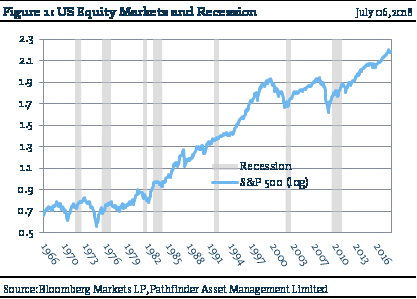Recap & Macro Outlook: Equity Returns and Recessions
Over the past number of months, our “Outlooks” have been focused on the United States. Specifically, we have written about employment trends, inflation prospects, business confidence and potential changes in fixed income markets. We would like to point out that these topics focus on the health and trajectory of the US economy, to which the Canadian economy is inexorably linked, and that economies are different than stock markets. While either can lead and/or impact the other depending on the circumstances, they are in fact very different. We focus on economic trends because those tends impact the businesses that we invest in. These investments represent real factional ownership of an operating enterprise. This is different vs. stock market prices and financial and political headlines, which can dramatically impact the daily movement of financial markets. Economic and business evolution tends to be slow, while financial asset pricing is lightning fast. This often causes a disconnect between the quoted value of an asset (fear and greed) and our opinion of the true intrinsic value of that asset.

The price action of stock markets during recessions is worthy of consideration. The average fall of equity prices (as defined by the S&P 500) during post-World War II recessions is 30%. The average fall of markets ahead of the recession (as defined by the NBER) is 10% but, in some periods, equity markets rise until the peak is reached just a couple of months ahead of recession. In all but one recession period from 1948, the peak was achieved within a year of the recession. But in most cases, the peak is achieved within 6 months to a year of a recession. There were also three periods (1962, 1966 and 1987) where markets fell more than 20% and no recession followed (a “head fake” if you will). Recessions have lasted between 6 and 18 months and markets have taken as little as 3 months and as long as 5 years to recover to pre-recession levels.
Considering the above two paragraphs, our conclusions about the economy and the companies that we invested in seems relatively logical, while the data surrounding price action is very random. Does it make sense that all companies are suddenly worth 30% less in a recession? And then, a relatively short-time later, they are worth the same again? Good companies do the same thing month in and month out: They generate cashflow for owners by selling to their customers.
“This means that” while we grow more cautious, we still see little problem with the US economy and, other than a flattening yield curve, see little medium-term risk (this can change?!). We focus our efforts on finding great companies at fair prices.
National Instrument 31-103 requires registered firms to disclose information that a reasonable investor would expect to know, including any material conflicts with the firm or its representatives. Doug Johnson and/or Pathfinder Asset Management Limited are an insider of companies periodically mentioned in this report. Please visit www.paml.ca for full disclosures.
*All returns are time weighted and net of investment management fees. Returns from the Pathfinder Partners’ Fund and Partners’ Real Return Plus Fund are presented based on the masters series of each fund. The Pathfinder Core: Equity Portfolio and The Pathfinder Core: High Income Portfolio are live accounts. These are actual accounts owned by the Pathfinder Chairman (Equity) and client (High Income) which contain no legacy positions, cash flows or other Pathfinder investment mandates or products. Monthly inception dates for each fund and portfolio are as follows: Pathfinder Core: Equity Portfolio (January 2011), Pathfinder Core: High Income Portfolio (October 2012) Partners’ Fund (April 2011), Partners’ Real Return Plus Fund (April, 2013), and Partners’ Core Plus Fund (November 2014).
Pathfinder Asset Management Limited (PAML) and its affiliates may collectively beneficially own in excess of 10% of one or more classes of the issued and outstanding equity securities mentioned in this newsletter. This publication is intended only to convey information. It is not to be construed as an investment guide or as an offer or solicitation of an offer to buy or sell any of the securities mentioned in it. The author has taken all usual and reasonable precautions to determine that the information contained in this publication has been obtained from sources believed to be reliable and that the procedures used to summarize and analyze such information are based on approved practices and principles in the investment industry. However, the market forces underlying investment value are subject to sudden and dramatic changes and data availability varies from one moment to the next. Consequently, neither the author nor PAML can make any warranty as to the accuracy or completeness of information, analysis or views contained in this publication or their usefulness or suitability in any particular circumstance. You should not undertake any investment or portfolio assessment or other transaction on the basis of this publication, but should first consult your portfolio manager, who can assess all relevant particulars of any proposed investment or transaction. PAML and the author accept no liability of any kind whatsoever or any damages or losses incurred by you as a result of reliance upon or use of this publication.